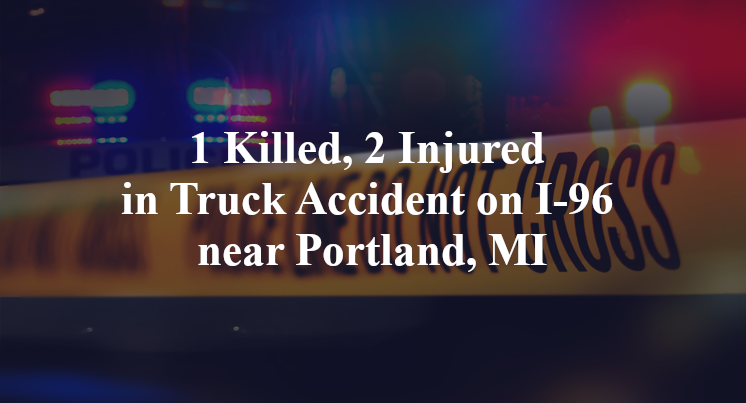1 Killed, 2 Injured in Truck Accident on I-96 near Portland, MI
Ionia County, MI — August 26, 2025, one person was killed and two others were injured in a truck accident at about 5 p.m. on Interstate 96 near Portland.
Authorities said a semi-truck was heading west near Sunfield Highway when it crashed into two SUVs as traffic slowed approaching a construction zone. One SUV was pushed off the road, while the other was forced into the back of another semi-truck.

One person died at the scene of the crash, according to authorities, while two other people were hospitalized with serious injuries. It is not clear how they were involved in the accident at this time.
Authorities have not released any additional information about the Ionia County crash. The accident is still under investigation.
Commentary
When a crash happens near a construction zone, most people want to know one thing: How could something so preventable still happen? Construction slowdowns are typically well-marked and highly visible. So if a truck runs into stopped traffic, as appears to have happened here, the real issue becomes whether that driver had the time and awareness to respond appropriately, and if not, why not?
According to initial reports, a semi-truck on westbound I-96 rear-ended two SUVs as traffic slowed near a construction area. One SUV was pushed off the road; the other was forced into the back of another truck. One person died at the scene, and two others were hospitalized. But beyond these outcomes, what we don’t know yet is equally important.
It’s not clear whether the truck driver failed to slow down, didn’t see the traffic backup or couldn’t stop in time. Each of those possibilities points to a different set of questions: about distraction, speed, vehicle condition or perhaps even how the construction zone was managed. These aren’t abstract concerns. They’re questions that only a detailed investigation can answer.
That investigation should start with the truck itself. Most modern trucks are equipped with ECMs, or “black boxes," that record speed, brake use, throttle position and more in the seconds before a crash. If the truck had forward-facing cameras or in-cab monitoring, that could help show whether the driver was alert, distracted or possibly impaired. Cell phone records might reveal if the driver was on a call or texting. All of this evidence is essential to determining whether this was a momentary lapse or a much deeper failure.
What about the trucking company? Was this a driver with a clean record or a history of safety issues? Did the company provide proper training and screening, or did they cut corners to keep a seat filled? I’ve handled cases where a trucking company hired a driver with multiple prior firings and gave them a road test that barely scratched the surface of their actual skills. That kind of negligence may not be visible from a crash report, but it’s often central to understanding how a crash like this could happen.
There’s also the matter of the second semi-truck involved. The report says one SUV was forced into the back of it, but doesn’t say whether that truck was stopped or moving. If it was stationary, was it in the lane or on the shoulder? If it was moving, was it part of the chain reaction or a separate hazard altogether? These unanswered questions highlight just how complex truck crashes can be, and how misleading it is to rely solely on surface-level details.
What matters now is getting to the truth. That requires access to physical evidence, digital records, driver logs and maintenance history. Without that information, it's impossible to hold the right parties accountable, or prevent a similar crash from happening again.
Key Takeaways:
- It’s unclear whether the truck driver failed to slow down, was distracted or couldn’t stop in time. Each scenario requires different evidence to verify.
- Investigators should recover ECM data, in-cab camera footage and phone records to determine the truck driver's actions leading up to the crash.
- The trucking company’s hiring and training practices could play a role, depending on the driver's background.
- Questions remain about the role of the second semi-truck and whether its position contributed to the severity of the crash.
- Thorough investigation, not assumptions, is key to understanding who is responsible and why.

“These are essential reads for anyone dealing with the aftermath of a truck wreck”– Attorney Cory Carlson